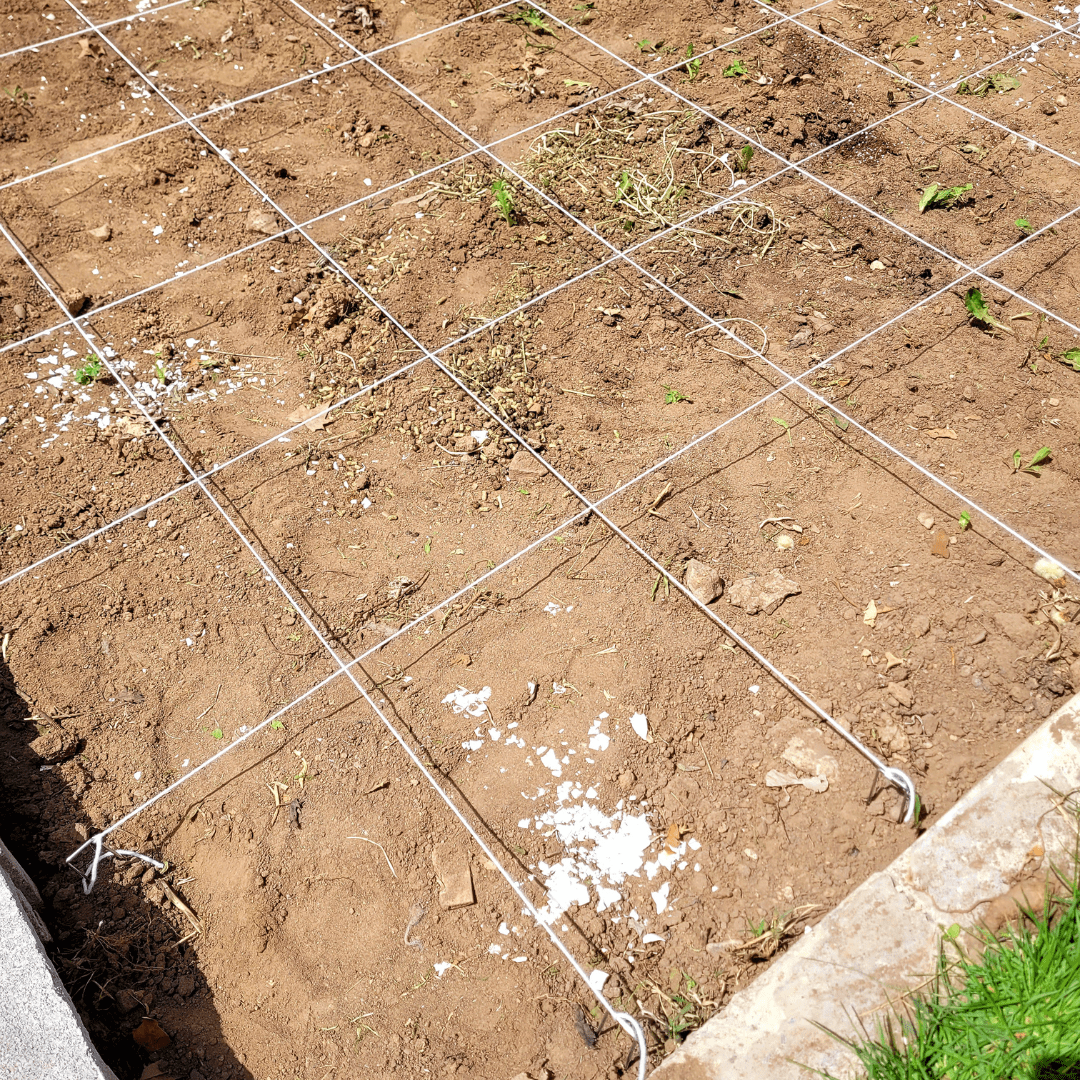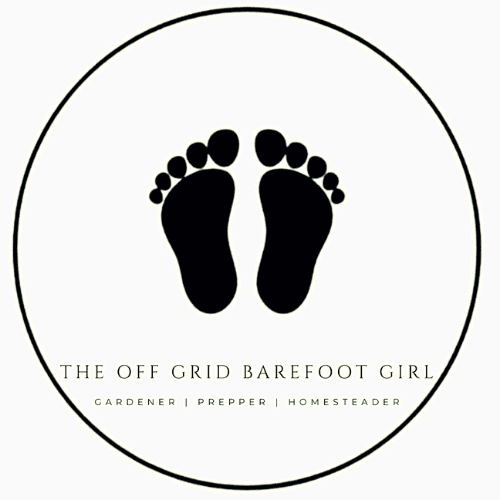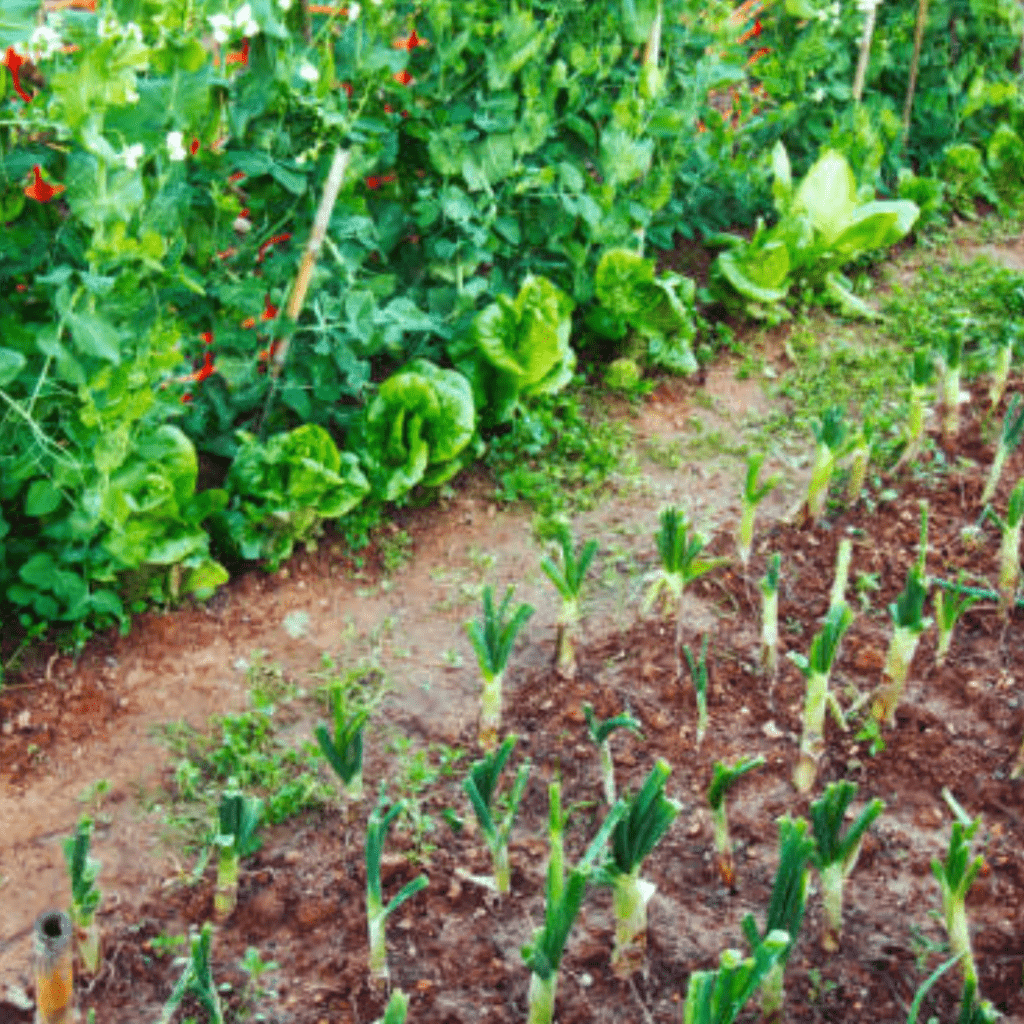Want to grow more food in less space? A square foot garden is the simple, organized way to plan a productive garden, even if you’re short on room. In this post, you’ll learn how to easily map out your garden, maximize your harvests, and enjoy a low-maintenance growing season—all with the square foot method!
Growing a square-foot garden has become popular in the suburbs considering how much food you can grow and harvest from a square-foot garden. Since yards have become smaller, people have migrated to square-foot gardening rather than the traditional rows of gardening that require a lot of gardening space.
In this post, I will discuss how I built my square foot garden, installed my grid, and what I grow in each square foot space. Further, I have created a Square Foot Garden Printable Planner loaded with ideas, grids, soil recipes for garden boxes, tools, companion planting charts, plant labels, and so much more for your convenience. So do not forget to grab your square-foot garden printable planner after reading this post!
This is a pinnable post. Tap or hover over any image in this post to pin to your Pinterest Boards.

Introduction to Square Foot Gardening
Square Foot Gardening is a popular and innovative gardening method that allows individuals to maximize their garden’s productivity in a limited space. With its efficient use of space, reduced maintenance, and increased yields, square-foot gardening has gained attention from both experienced gardeners and beginners alike.
In this article, I talk about the popular concept of square-foot gardening, explore its numerous benefits, guide you through the process of setting up and maintaining your own square-foot garden, troubleshoot common issues that may arise, and provide tips for harvesting and expanding your garden.
Whether you have a small balcony or a backyard, square-foot gardening can offer a practical and rewarding solution to growing your own fresh produce. One great way to do this is by planning out your square-foot garden planting space.
Understanding the Concept of Square Foot Gardening
When I first started gardening, I was overwhelmed by how much space and effort it seemed to take—until I discovered square-foot gardening. It’s a simple method that divides your garden into 1-foot squares, making it easy to plan, plant, and manage.
Each square can grow a different crop based on how much space it needs, which helps reduce waste and makes the most of every inch.
I love how organized and low-maintenance it is, especially since I can focus on just a few squares at a time instead of worrying about rows. It’s truly the easiest way I’ve found to grow a productive garden in a small space.
Benefits of Square Foot Gardening
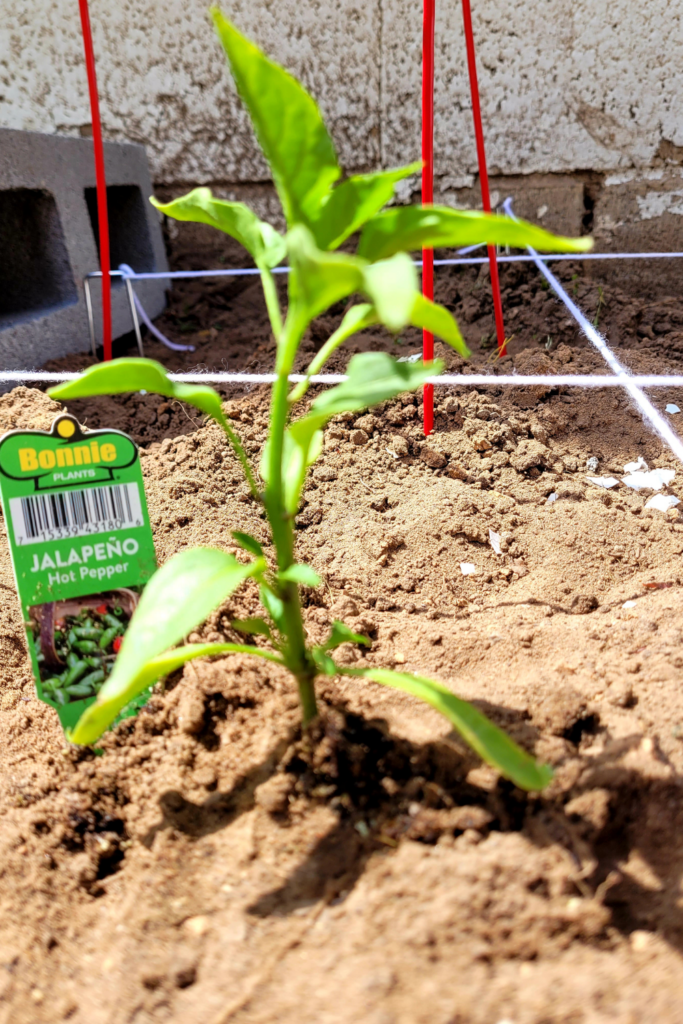
Maximizing Space Efficiency in Small Gardens
One of the reasons I love square-foot gardening is how it helps me get the most out of a small space. I don’t have a huge backyard, so every inch counts. By organizing my garden into individual foot-by-foot sections, I can plan exactly what goes where—no wasted space. I also take advantage of vertical space with trellises for things like peas, cucumbers, and beans.
It’s amazing how much you can grow when you’re intentional about spacing. My square-foot garden planner really helps me visualize everything before I plant, so I can fit more in without overcrowding.
Reducing Water Usage and Weed Growth
One of the biggest perks I’ve noticed with square-foot gardening is how much it cuts down on water usage and weeds. Since everything is planted close together, there’s less open soil for weeds to pop up and more shade on the soil surface to hold in moisture. I water only where it’s needed—right in the planted squares—so nothing goes to waste.
It’s way more efficient than watering large rows, and I spend way less time weeding. This method has been a game changer for keeping my garden low-maintenance and water-wise, especially during dry spells.
Easy Maintenance and Accessibility
One of the things I appreciate most about my square-foot garden is how easy it is to take care of. Since everything is laid out in small, manageable sections, I can focus on one square at a time without feeling overwhelmed.
Whether I’m pulling a few weeds, checking on seedlings, or harvesting dinner, everything is within reach and simple to maintain. It really takes the stress out of daily garden care.
Why Grow A Square Foot Garden

I grow a square-foot garden in my yard because I can make this type of garden much more accessible. I can care for and harvest my plants easily as well because of the 4×4 or 4×10 garden boxes that make reaching around the plants so much easier.
I also have a larger square foot garden shown in the above image that I recently sectioned off into smaller areas. The following photo is my newly sectioned square-foot garden that I call my survival garden.
This is my 200-square-foot garden which you can read more about in my How to Plan a 200-Square-Foot Vegetable Garden Layout post. I have added a path down the center to help me access areas much better. I would rather not feel like a mean giant trampling all over my precious plants! Paths and access spaces are so important in garden beds!

Square foot gardening helps me to be able to install a grid for easy layouts to keep my plants nicely spaced and properly in their places. I can install water irrigation for each box to ensure my plants are adequately hydrated. I do not have to combat weeds all season and I do not have to till my ground!
There are a ton of fun tools for square-foot gardening on the market that make this type of gardening fun. There are seed spacing mats, water irrigation grids, grid boxes, prebuilt garden boxes, soil mixes, water globes, greenhouse boxes, and so much more fun stuff.
Learn more about these fun tools in my planner and get your free seed spacing paper mats, plant labels, companion charts, and much more with my square-foot garden printable planner.
Square Foot Garden Printable Planner
How to Plan Square Foot Garden Layouts
When setting up your square foot garden, select a location that receives at least six hours of sunlight per day. Avoid areas with strong winds or excessive shade, as they can adversely affect your plants’ growth. If growing in containers, ensure you have proper drainage to prevent waterlogging.
When planning to grow a square-foot garden layout, it is important to monitor the sun-exposed areas of your yard and determine the placement of each garden bed. You can begin to lay out your square-foot garden plan with different types of grid layouts.
Also, you can plan the layout grids in 4×2, 4×4, 4×8, and 4×10 grids or even squeeze in a 2×2 grid layout in smaller areas to fit more plants in corner spaces. You can plan to fit all different types of grid layout boxes in different areas of your yard, which is the beauty that I love about growing a square-foot garden and using a square-foot garden planting chart.
Using Helpful Printable Grid Layouts
You can get the printable grid layouts in my Square Foot Garden Printable Planner and begin to plan the layout of your very own square-foot garden according to your own needs. You can customize your square-foot garden to meet the requirements of your yard space and sunlight areas by utilizing a square-foot garden planting chart.
Consider using the printable layout to sketch or write in each square space what plant you want to plant and where you want to plant it in your square-foot garden. It is simple to use the printable blank square grids to plan your plant spacing with the plant spacing guide that is included in my planner. This means you can for sure know how many tomatoes, carrots, beans, etc. per square foot is required.
If you are unsure of how many cucumbers, zucchini, beets, or whatever you want to plant per square foot, my picture chart is easy to follow to plan your layouts so be sure to grab your planner!
Square Foot Garden Printable Planner
Boxes and Grids For Square Foot Gardens
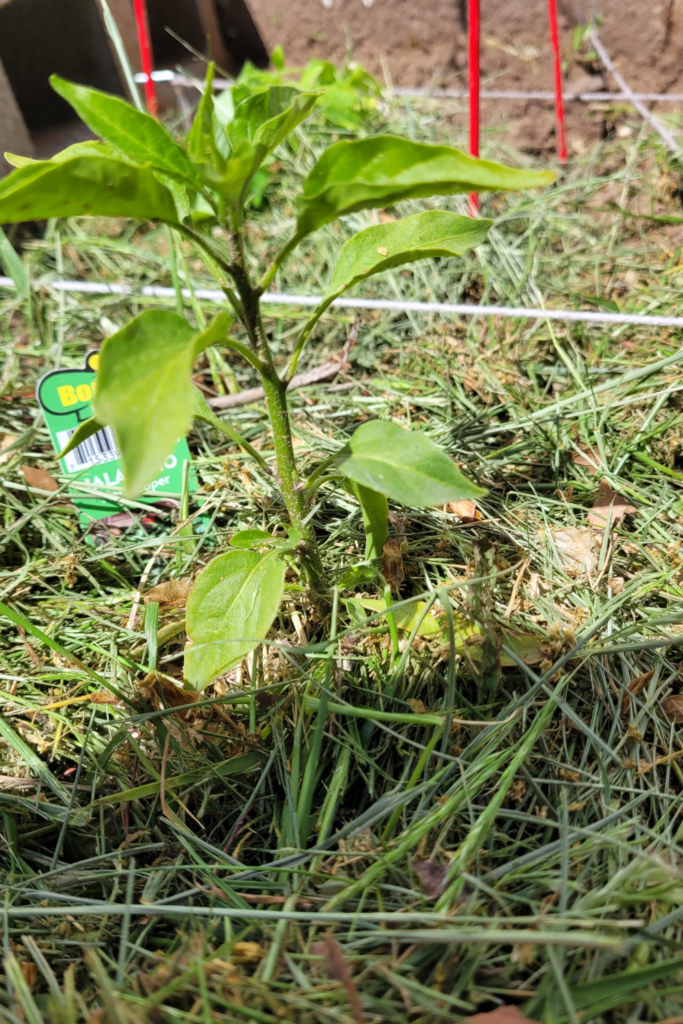
You can build your own raised garden boxes and make your own grids or you can simply buy them in a kit. You can get creative when building your raised garden beds and use wood or bricks to construct your raised garden beds.
Building your garden grids can be as simple as using twine or thin boards nailed to the wooden garden beds. If you are unable to nail your grid to the garden beds because of the type of material it is built with, such as bricks, you can still easily add a grid by using twine and in-ground tent pegs.
While you can garden without a square-foot garden grid, installing a grid is helpful for proper plant placement and it looks extremely neat and very organized.
If you do not want to use a grid, you can map out your square-foot spaces with a square-foot tool or a five-gallon bucket. If you turn a five-gallon bucket upside down and twist the rims into the soil to create a circle, you now have one square foot of garden space, even though it is a circle.
5-Gallon Bucket Mobile Square Foot Garden
One five-gallon bucket is equivalent to one square foot of garden space. Buckets make it easy to extend your square-foot garden. It actually becomes a mobile square-foot garden since buckets can be moved around!
Soil Recipe For A 4×4 6 Inch Box
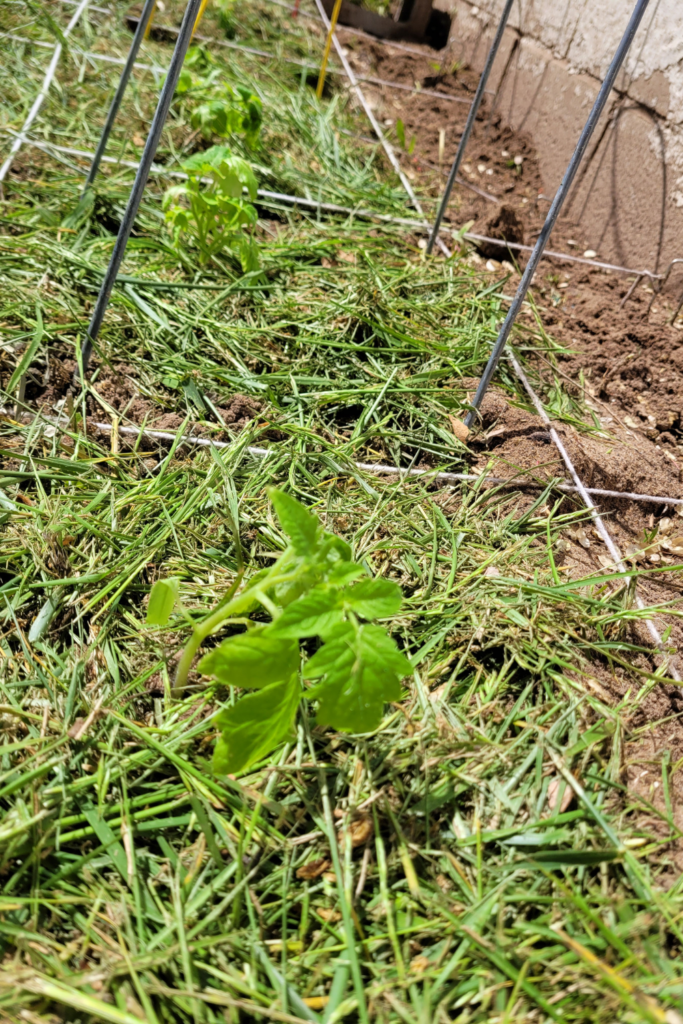
Square foot gardens in raised beds need proper soil amendments that are full of nutrition. It is important to add more nutrient-rich compost to the garden beds to ensure an adequate supply of nutrients for the new plants for each growing season.
In my planner, I have shared the perfect soil recipe for a 4×4 square foot garden bed that is six inches deep. Go check it out, download it, and print out your planner. You can double or quadrible this soil recipe to fit your square foot garden soil needs and provide your plants with the best soil for a great headstart in their young life to grow strong.
Square Foot Garden Printable Planner
Water Irrigation Systems
Keeping your square-foot garden hydrated is crucial for the health and growth of your plants. While it’s important to water regularly, you should also be mindful of not overwatering, as this can lead to root rot and other problems. One effective method is to use a drip irrigation system, which delivers water directly to the base of your plants, minimizing water waste and evaporation.
Alternatively, you can water by hand, ensuring each square foot receives adequate moisture. Just remember, plants don’t have timers, so don’t forget to water them even if you’re busy watching your favorite show!
There are tools on the market for water irrigation for square-foot gardens. There are irrigation tubes or square grid irrigation systems that can help keep your square-foot garden well watered.
The market even has some cute water globes that can be placed in a square space to water the plants that require a bit more watering. I really love those colorful water globes for a hands-off drip-watering experience. They are convenient and they come in packs.
Installing a water irrigation system will help you become a successful gardener since it brings water right to the roots of plants. The plants will be healthier than being sprayed overhead with a sprinkling system since overhead watering can cause most of the diseases and problems with plants by having the soil splashed up onto the plants with the harsh spray of water sprinklers.
Fertilization and Nutrient Management
To keep your square-foot garden thriving, it’s essential to provide it with the nutrients it needs. Incorporating organic compost or aged manure into your soil before planting can provide a rich source of nutrients. Additionally, consider using organic fertilizers to give your plants an extra boost throughout the growing season.
Just like humans, plants need a balanced diet, so be sure to follow the recommended guidelines for fertilization. And remember, feeding your plants doesn’t mean you have to spoon-feed them, sprinkle that fertilizer with style!
Weed, Pest, and Disease Control
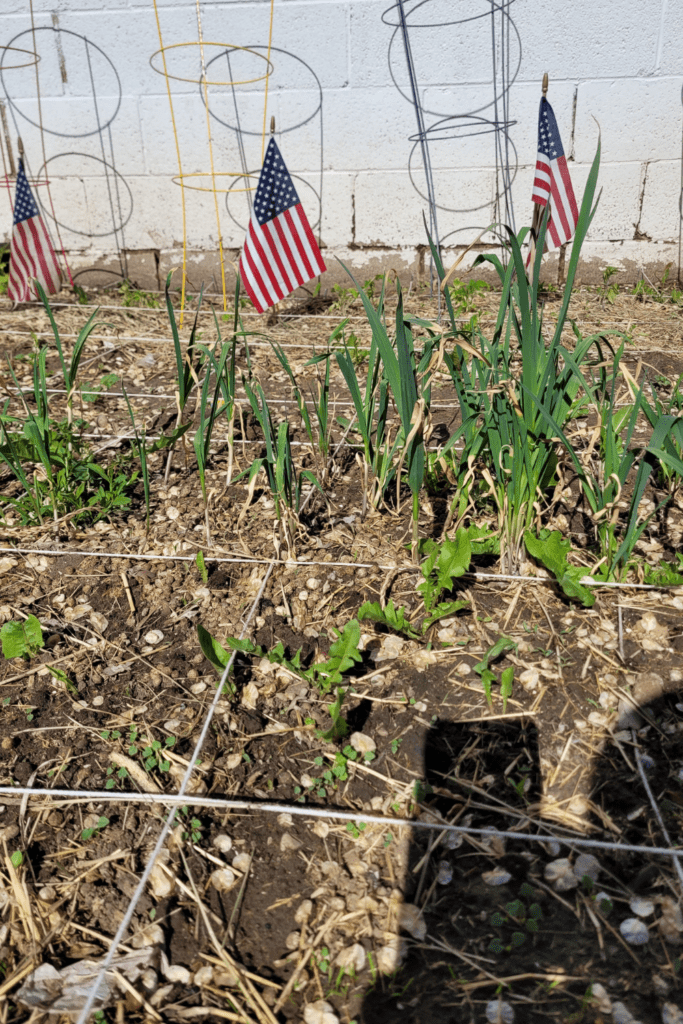
Nobody likes uninvited guests, especially when they come in the form of pests and diseases in your garden. To keep these troublemakers at bay, regularly monitor your plants for any signs of infestation or illness. Implement natural pest control methods such as companion planting, introducing beneficial insects, or using organic pest sprays. In the case of disease, quick action is vital.
Identify the issue, remove the affected plants or parts, and provide proper care to prevent further spread. Always remember, pests and diseases are the uninvited party crashers, and it’s your duty to kick them out!
Weed and pest control can be easily managed in a raised garden bed. High-quality weed control mats and barriers should be placed inside the garden box underneath the soil. By doing this, you will have less weed work in the garden and enjoy it more and it will look so beautiful.
Adding mulch to the square-foot garden will also help combat weeds. Weeds appear when the soil is bare, so be sure to keep it covered. Having mulch in the garden also provides added moisture and the soil will not dry out from exposure to the sun.
By taking these measures in your square-foot garden, you will find fewer pest problems. When the soil is neatly cared for, the number of pest problems will be lower. To help combat pests in the garden further, learn companion planting. Plants love helping each other and they have preferred friends that they love sitting by, just as we do! So be sure to learn who their friends are and plant them together.
Companion Planting Guide
If you do not know about plant companions, I have actually done the research for you. In my planner, you will find an extensive plant companion chart that is easy and fun to follow. I have listed each plant’s friends and foes so that you can have a successful square-foot garden. Be sure to check it out!
Also, I have written a post about companion planting if you are not interested in the planner.
How to Do Companion Planting: Friends or Foes?
Square Foot Garden Printable Planner
Dealing with Overcrowding
When I first started square-foot gardening, I was so excited to grow everything that I ended up planting too much in a few of my squares—and quickly learned the importance of spacing. Overcrowding can lead to poor air circulation, smaller harvests, and even pest issues.
Now, I use the spacing guides in my square foot garden planner to map out exactly how many plants each square can handle. It helps me stay disciplined and gives each plant enough room to thrive. If I ever do notice things getting a little crowded, I thin them early and use the extras in another part of the garden or in containers to extend my garden (I do this a lot).
Identifying and Addressing Plant Diseases
One thing I’ve learned from square-foot gardening is how important it is to catch plant problems early—especially diseases. Because everything is so compact, I walk through my garden daily and it’s easy to spot when something looks off. Whether it’s yellowing leaves, spots, or wilting, I make a quick note in my garden journal and look into the cause right away.
Having a plant profile page for each crop in my planner helps me track patterns and treatments that worked. Staying on top of plant health means I can act fast and keep issues from spreading to neighboring squares.
Preventing and Managing Weed Growth
Weed control used to feel like a never-ending battle in my garden—until I switched to square-foot gardening. With this method, the densely planted squares naturally shade the soil, which helps keep weed seeds from sprouting in the first place. I also use compost and mulch to cover any bare spots and suppress weeds even further.
When weeds do pop up, they’re easy to spot and pull since I’m working in small sections at a time. It’s a lot less overwhelming, and staying ahead of them has become part of my simple weekly routine.
Planting Guides and Tools

I don’t have wooden garden borders, so instead of using nails or screws to mark out my square foot grid, I came up with a simple workaround. I use weed barrier fabric staples—those U-shaped metal ones—as grid holders.
Since my garden borders are concrete, I just press the staples into the soil at the edge of each square, looping string through them to create the grid. It’s quick, doesn’t damage anything, and holds the layout in place all season long. Plus, it’s easy to adjust if I ever want to rework the spacing!
Seed Starting & Plant Profile Pages
One of the things that really keeps me organized during the growing season is using seed starting and plant profile pages. They help me track what I planted, when I started it, how well it grew, and any notes I want to remember for next year. I use them to jot down germination times, transplant dates, and even harvest notes. That way, I’m not relying on memory alone—especially when things get busy in the garden.
There once was a time when I thought to myself, “Oh, I will remember I planted this!” Then came to find later that I was missing 4 loofah plants that never sprouted and I had no clue where I started them because I did not document them physically. If I had remembered, I would have been there for them as babies when they first sprouted, giving them a chance. But I neglected them because I mentally documented them, which is obviously not a good thing with my brain!
So my handy-dandy Square Foot Garden Printable Planner was born!
My Square Foot Garden Printable Planner includes dedicated pages for both seed starting and plant profiles, so everything stays in one place and I can easily refer back to it anytime. It’s been a game changer for planning and improving my garden year after year!
It is extremely useful and helpful as a gardener so I wanted to share it with you, too! So I have provided many links throughout this post to help you get your copy!
Square Foot Garden Printable Planner
Garden Journal Pages for Notes & Observations
I’ve learned that keeping a garden journal makes a big difference, especially when I look back on past seasons. I use the journal pages in my printable planner to jot down little observations—like when something started blooming, pest problems I noticed, or even unexpected successes.
These notes help me improve each year, and honestly, it’s just fun to see how the garden changes over time. The planner includes dedicated space for notes, making it easy to track the ups and downs of the season.
Square Foot Garden Printable Planner
Plantable Seed Starter & Seed Spacing Mats
One of my favorite tools for square-foot gardening is using plantable seed starter mats made from biodegradable paper. I pre-mark the spacing on the paper to match the square foot layout, then place the seeds right on top and fold it over. When it’s time to plant, I just lay the entire mat in the soil and cover it—no measuring or guessing needed.
The paper breaks down naturally, and the spacing is perfect every time. It saves me so much time during planting season and helps keep my garden neat and efficient right from the start.
Companion Planting Chart
As previously mentioned, companion planting in the garden is important to help the plants not only survive but thrive. They can provide additional benefits for one another simply by being planted next to one another. Like us, plants have their friends and foes. Learn more about companion planting for gardening with a handy list of plant friends and foes in my planner.
Plants that like each other, attract beneficial insects and pollinators to each other as well as repel pesky enemies to keep each other safe, happy, and healthy. Remember your tight-knit friend group in school when you all looked out for each other? Keeping your enemies out and your friends in is exactly the same thing that plants like to do too.
When you keep their foes away from them, you will prevent your garden from acquiring diseases and pests and find that you do not need extra help with chemicals just to be successful. If you skip companion planting in your garden, you are more likely to resort to using chemicals on your plants.
Learn more about companion planting with my other post How to Do Companion Planting: Friends or Foes?
Printable Plant Markers
One of the best things I enjoy about square-foot gardening is the nice organizational presentation you can accomplish. Having some plant markers can help bring a gorgeous organized presentation to your square-foot garden.
Keep your garden organized and well-labeled for everyone to see what each row or plant is that is neatly planted. Having labels in your garden helps showcase the plants that are thriving in it. It also helps everyone know what plant is in the garden. It is especially helpful at harvest time too!
I like to print out my adorable plant markers, cut them out, and mod podge them onto wooden craft squares to seal them up and glue a stake to the backside.
I designed these plant markers to fit over the small wooden craft squares that you find in craft stores that are sold in packs.
Square Foot Garden Printable Planner
Here it is! My Square Foot Garden Printable Planner!
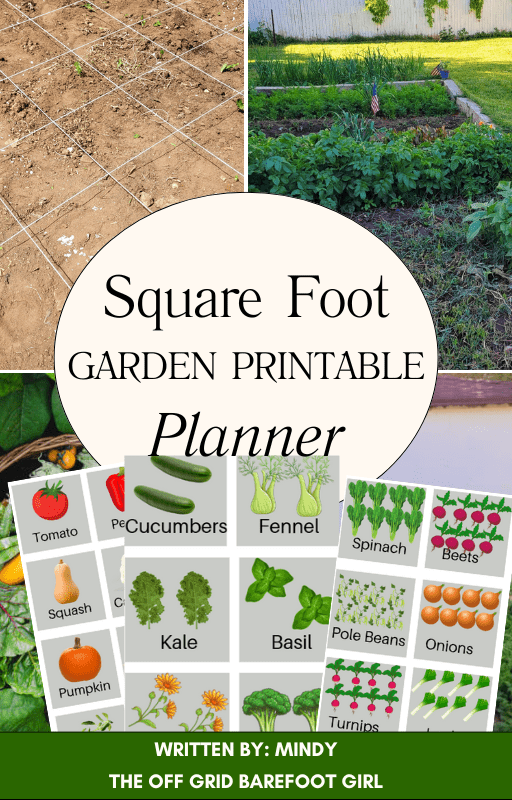
Conclusion
In conclusion, utilizing a square-foot gardening planting chart is a simple yet highly effective way to maximize your gardening space and yield. By following this straightforward method, you can easily plan your garden layout, ensuring that each plant has enough room to thrive while minimizing waste and optimizing productivity.
Whether you’re a seasoned gardener or just starting, this technique allows for flexibility and creativity in your garden design. With careful planning and consideration, your square-foot garden can flourish, providing you with a bountiful harvest. So grab your planner, gather your seeds, and enjoy the satisfaction of nurturing your own vibrant and productive garden!
Resources: Here are some helpful resources for further information.
- Planting Chart Cheat Sheets – By Square Foot Gardening Foundation
- Square Foot Garden Plant Spacing Guide – By Garden In Minutes
- Square Foot Gardening – By Phipps Conservatory
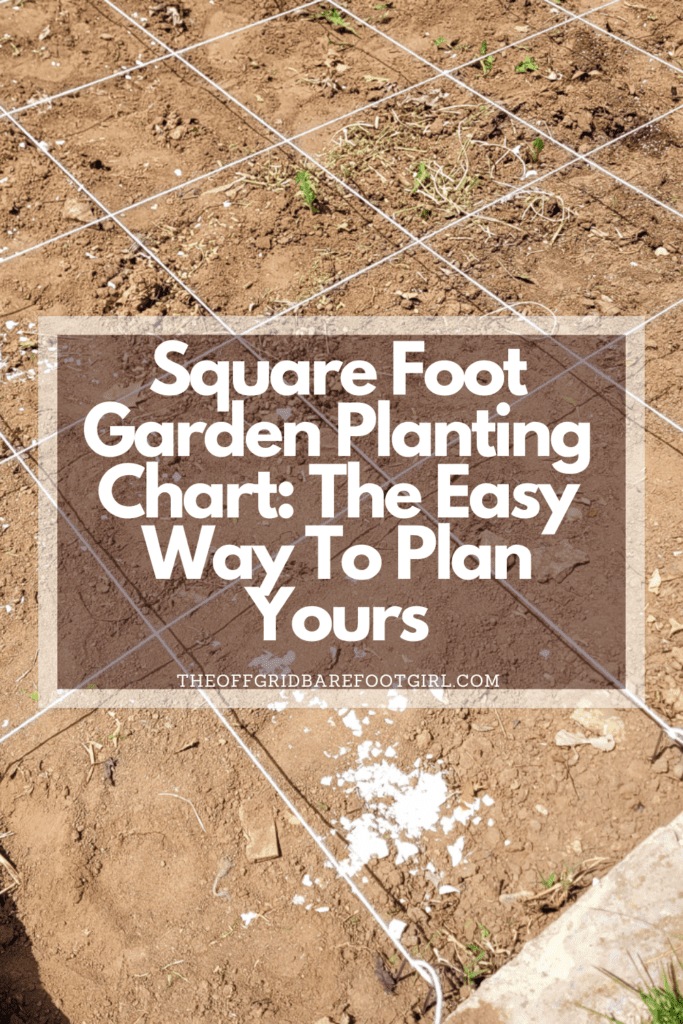
Frequently Asked Questions
1. What is a square-foot gardening planting chart?
A square-foot gardening planting chart is a visual tool that helps gardeners plan their garden layout by dividing the space into one-foot squares. Each square can be allocated to a specific plant type, allowing for efficient use of space and resources.
2. How do I use a square-foot gardening planting chart?
To use the chart, simply determine the size of your garden bed and create a grid with one-foot squares. Then, consult the chart to see how many plants can fit in each square, based on their recommended spacing. This will guide you in planting the right amount of each crop.
3. What plants are best suited for square-foot gardening?
Many plants work well in square-foot gardening, including tomatoes, peppers, lettuce, radishes, and herbs. It’s essential to consider each plant’s space requirements when planning your layout to ensure optimal growth.
4. Can I customize my planting chart?
Absolutely! The beauty of square-foot gardening is its flexibility. You can customize your planting chart to fit your preferences, climate, and available space. Experiment with different plant combinations and layouts to find what works best for you.
Summary
I hope I have inspired you to plant garlic in your garden with these tips and products.
If you were encouraged by this post, I invite you to check out my FREE Printables Page for fun free printables, planners, and charts.
ENTER MY FREE Printables Page HERE
Here are some more of my gardening inspiration posts to check out!
The Best Essential Oils for Plants That Repel Garden Bugs
How to Grow Green Garden Peas: Perfect Plump Peas!
Hugelkultur: Does This Epic Pioneering Method Actually Work?
9 Ways to Celebrate Earthing Day in Your Garden!
Gardening Indoors: Secrets of Growing Your Food Inside!
How to DIY a Milk Jug Drip Irrigation System!
Why Cedar Mulch Is The Perfect Natural Weed Barrier
Onions: How to Grow Onions for Storage
Peas: How to Grow Garden Peas for a Bumper Crop
Carrots: How to Grow Carrots for a Bountiful Harvest
Prep Your Garden for Spring Planting with These Expert Tips!
How to Grow a Prepper Garden to Survive and Thrive
The Best Garden Tools You Need for a Productive Season
Fastest Growing Vegetables for Your Survival Garden
How to Grow Marigolds As Pest Control In Your Vegetable Garden
Must-Have Tools for a Successful Balcony Vegetable Garden
How to Effectively Combat Powdery Mildew in Your Garden
The Best Tips for Organic Gardening
How to Release Ladybugs In Your Garden for Organic Pest Control
The Best Garden Snail Control Strategies
The Best Spring Vegetables to Grow in Your Garden
Seed Starter Mix: How To Make Your Organic Seed Starter Mix At Home
How to Grow a Productive Canning Garden
How to Plant and Grow a Salsa Garden
Easiest Heirloom Vegetable Seeds to Grow Now
How to Use the Hand Twist Claw Tiller: Tackling Tough Soil
More Fun Gardening Posts to Check Out!
Planning Your Garden: How to Plan a Vegetable Garden: Expert Green Thumb Tips!
Winterizing the Garden: How to Winterize Your Vegetable Garden: Step-by-Step Checklist
Mulching the Garden: How to Make Leaf Litter Mulch
Grow a Pumpkin Patch: How to Grow a Pumpkin Patch in Your Backyard
How to Grow a Fall Garden: 9 Best Fall Crops
Clever Ways to Incorporate Indoor Composting into Your Home
How to Start Composting for the Garden: A Step-by-Step Guide
The Ultimate Guide to Composting in Your Suburban Backyard
Why I Built A Survival Garden in My Backyard
16 Best Medicinal Herbs to Grow in Your Garden Now
Blessings,
The Off Grid Barefoot Girl

